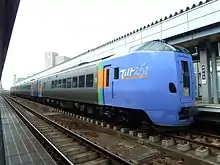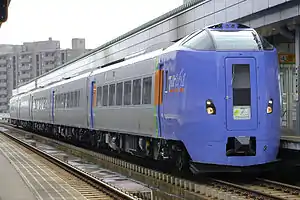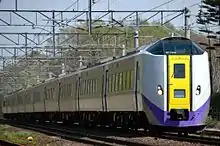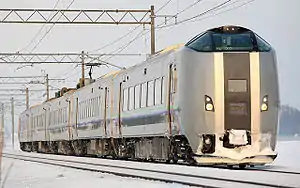KiHa 261 series
The KiHa 261 series (キハ261系) is a tilting diesel multiple unit (DMU) train type operated by Hokkaido Railway Company (JR Hokkaido) on limited express services in Hokkaido, Japan, since 2000.[1]
| KiHa 261 series | |
|---|---|
 KiHa 261 series on a Super Sōya service in February 2010 | |
| In service | 2000–Present |
| Manufacturer | Fuji Heavy Industries, JR Hokkaido |
| Constructed | 1998– |
| Number under construction | 28 vehicles |
| Number built | 35 vehicles |
| Number in service | 35 vehicles |
| Formation | 4-6 cars per trainset |
| Operator(s) | JR Hokkaido |
| Depot(s) | Naebo |
| Specifications | |
| Car body construction | Stainless steel |
| Car length | 21,300 mm (69 ft 11 in) (intermediate) 21,470 mm (70 ft 5 in) (261-0 end) 21,670 mm (71 ft 1 in) (261-1000 end) |
| Width | 2,800 mm (9 ft 2 in) (261-0) 2,928 mm (9 ft 7.3 in)(261-1000) |
| Height | 4,012 mm (13 ft 2.0 in) (261-0) 3,982 mm (13 ft 0.8 in)(261-1000) |
| Doors | 1 per side |
| Maximum speed | 130 km/h (81 mph) |
| Prime mover(s) | N-DMF13HZH (460 hp) x1 or 2 per car |
| Transmission | Hydraulic |
| Track gauge | 1,067 mm (3 ft 6 in) |
Design
The running gear was based on the KiHa 201 series trains introduced in 1997, and the body design was a joint venture with the Danish State Railways (DSB).[2]
Fleet
As of 1 April 2013, 35 KiHa 261 series vehicles were in operation.[3] 14 were built by Fuji Heavy Industries, and 21 were built by JR Hokkaido.[3] A further 28 vehicles are on order to be delivered from fiscal 2015.[4]
Operations
KiHa 261 series trainsets are used on the following services.[1]
KiHa 261-0 Series
- Sōya services between Sapporo and Wakkanai, since 11 March 2000
- Sarobetsu services between Asahikawa and Wakkanai, since 4 March 2017
KiHa 261-1000 Series
Formations
Sōya
Sōya services are normally formed of four-car KiHa 261-100 series sets, and are sometimes lengthened to six cars during busy periods.[5]
4-car formations
Four-car sets are formed as follows.[5]
| Car No. | 1 | 2 | 3 | 4 |
|---|---|---|---|---|
| Numbering | KiRoHa 261-200 | KiHa 260-200 | KiHa 260-100 | KiHa 261-100 |
6-car formations
Six-car sets are formed by adding two cars as shown below. Car 1 (and car 21) includes Green (first) class and standard class accommodation.[5]
| Car No. | 1 | 2 | 3 | 4 | 5 | 6 | |
|---|---|---|---|---|---|---|---|
| Numbering | KiRoHa 261-200 | KiHa 260-200 | KiHa 260-100 | KiHa 261-100 | KiHa 260-100 | KiHa 261-100 |
| Car No. | 21 | 22 | 1 | 2 | 3 | 4 | |
|---|---|---|---|---|---|---|---|
| Numbering | KiRoHa 261-200 | KiHa 260-200 | KiRoHa 261-200 | KiHa 260-200 | KiHa 260-100 | KiHa 261-100 |
Super Tokachi

Super Tokachi services were originally formed of five-car KiHa 261-1000 series sets, but these were later reduced to four cars.[1]
The 4-car Super Tokachi sets are formed as follows.
| Car No. | 1 | 2 | 3 | 4 |
|---|---|---|---|---|
| Numbering | KiRo 261-1100 | KiHa 260-1100 | KiHa 260-1200 | KiHa 261-1200 |
Interior
 Interior of Green car KiRo 261-1102 in April 2009
Interior of Green car KiRo 261-1102 in April 2009 Interior of ordinary-class car KiHa 260-1102 in April 2009
Interior of ordinary-class car KiHa 260-1102 in April 2009
History

A four-car pre-production set was delivered from Fuji Heavy Industries in November 1998 for evaluation and testing.[1][2] The first production trains were introduced on Super Sōya services between Sapporo and Wakkanai from the start of the revised timetable on 11 March 2000.[1]
New KiHa 261-1000 series 5-car sets were introduced on Super Tokachi services between Sapporo and Obihiro from October 2007.[1]

A further 28 KiHa 261 series vehicles were delivered from 2015 onward, and these are not equipped with tilting capability.[4]
From December 2015 until the end of 2017, the KiHa 261-1000 series fleet were gradually repainted into a new livery with white front ends, yellow front-end gangway doors, and a purple bodyside stripe.[6]
References
- Haraguchi, Takayuki (2009). Jr全車両: ビジュアル決定版 Encyclopedia of JR's Railway Cars: JR全車輌. Japan: Sekai Bunka. p. 115. ISBN 978-4-418-09905-4.
- Jēāru zensharyō handobukku: Rail Magazine 2009 JR全車輌ハンドブック2009 [JR Rolling Stock Handbook 2009]. Japan: Neko Publishing. 2009. pp. 448–449. ISBN 978-4-7770-0836-0.
- JR電車編成表 2014冬 [JR EMU Formations - Winter 2014]. Japan: JRR. 1 December 2013. p. 391. ISBN 978-4-330-42413-2.
- 車体傾斜装置、取りやめ検討 JR北海道、15年度以降導入の28両 将来の高速化に足かせも [JR Hokkaido to abandon tilt: 28 vehicles on order from FY2015 may hinder future speed increases]. Doshin (in Japanese). Japan: The Hokkaido Shimbun Press. 5 December 2013. Archived from the original on 6 December 2013. Retrieved 9 December 2013.
- JR気動車客車編成表 '04年版 [JR DMU & Coaching Stock Formations - 2004]. Japan: JRR. 1 July 2004. p. 16. ISBN 978-4-88283-125-9.
- JR北海道,キハ261系1000番台のエクステリアデザインを変更 [JR Hokkaido to modify exterior styling of KiHa 261-1000 series]. Japan Railfan Magazine Online (in Japanese). Japan: Koyusha Co., Ltd. 10 September 2015. Retrieved 10 September 2015.
External links
| Wikimedia Commons has media related to KiHa 261 series. |
- JR Hokkaido KiHa 261 Super Soya train information (in Japanese)
- JR Hokkaido KiHa 261/283 Super Tokachi train information (in Japanese)
